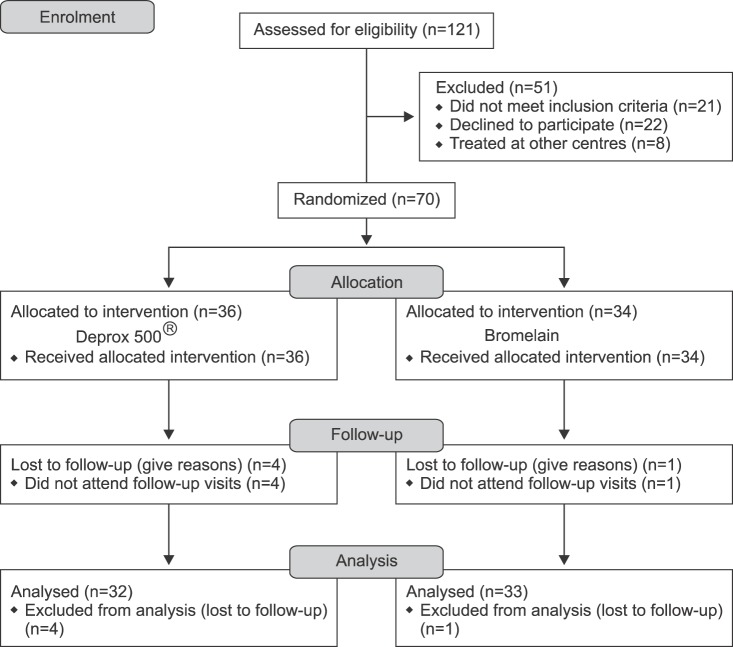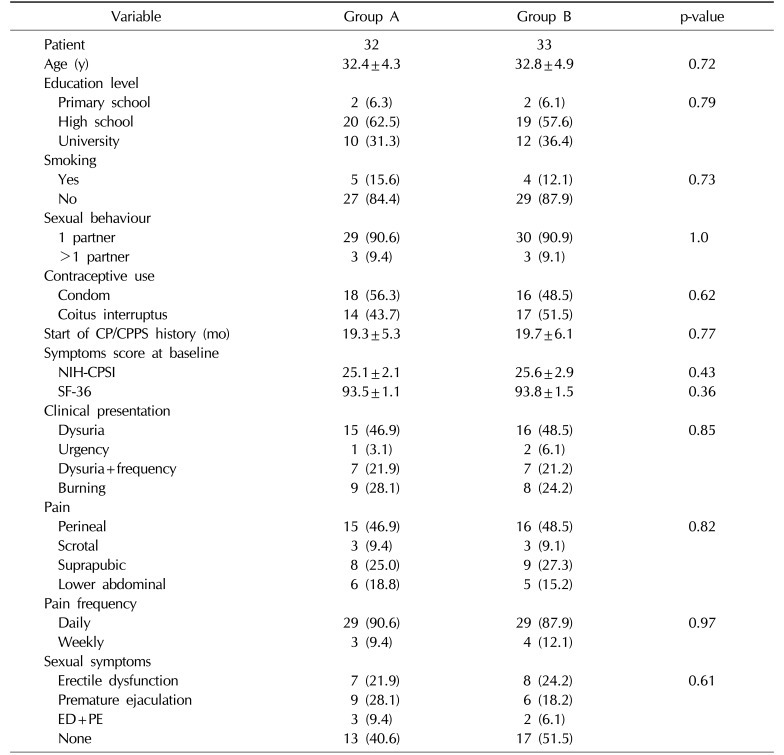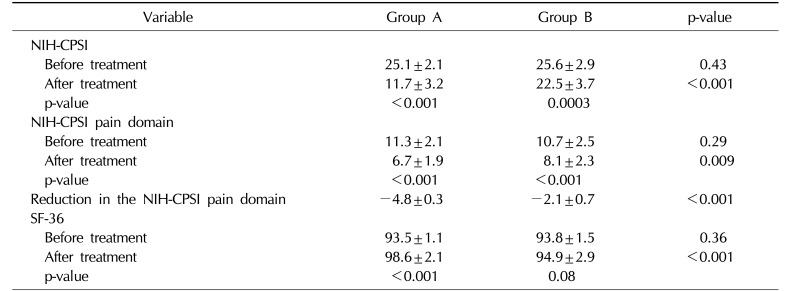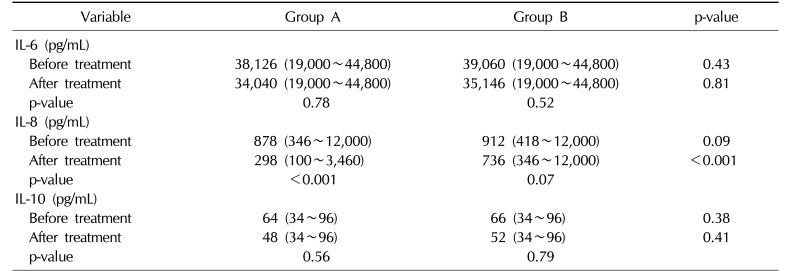1. Collins MM, Stafford RS, O'Leary MP, Barry MJ. How common is prostatitis? A national survey of physician visits. J Urol. 1998; 159:1224–1228. PMID:
9507840.

2. Schaeffer AJ. Classification (traditional and National Institutes of Health) and demographics of prostatitis. Urology. 2002; 60(6 Suppl):5–6. discussion 6-7. PMID:
12521577.

3. Nickel JC. Role of alpha1-blockers in chronic prostatitis syndromes. BJU Int. 2008; 101(Suppl 3):11–16.
4. Tuğcu V, Taşçi AI, Fazlioğlu A, Gürbüz G, Ozbek E, Sahin S, et al. A placebo-controlled comparison of the efficiency of triple- and monotherapy in category III B chronic pelvic pain syndrome (CPPS). Eur Urol. 2007; 51:1113–1117. discussion 1118. PMID:
17084960.

5. Nickel JC, Downey J, Clark J, Casey RW, Pommerville PJ, Barkin J, et al. Levofloxacin for chronic prostatitis/chronic pelvic pain syndrome in men: a randomized placebo-controlled multicenter trial. Urology. 2003; 62:614–617. PMID:
14550427.

6. Herati AS, Moldwin RM. Alternative therapies in the management of chronic prostatitis/chronic pelvic pain syndrome. World J Urol. 2013; 31:761–766. PMID:
23740129.

7. Shoskes DA, Zeitlin SI, Shahed A, Rajfer J. Quercetin in men with category III chronic prostatitis: a preliminary prospective, double-blind, placebo-controlled trial. Urology. 1999; 54:960–963. PMID:
10604689.

8. Rugendorff EW, Weidner W, Ebeling L, Buck AC. Results of treatment with pollen extract (Cernilton N) in chronic prostatitis and prostatodynia. Br J Urol. 1993; 71:433–438. PMID:
8499988.
9. Cai T, Luciani LG, Caola I, Mondaini N, Malossini G, Lanzafame P, et al. Effects of pollen extract in association with vitamins (DEPROX 500®) for pain relief in patients affected by chronic prostatitis/chronic pelvic pain syndrome: results from a pilot study. Urologia. 2013; 80(Suppl 22):5–10. PMID:
23334883.

10. Kamijo T, Sato S, Kitamura T. Effect of cernitin pollen-extract on experimental nonbacterial prostatitis in rats. Prostate. 2001; 49:122–131. PMID:
11582591.

11. Wagenlehner FM, Schneider H, Ludwig M, Schnitker J, Brähler E, Weidner W. A pollen extract (Cernilton) in patients with inflammatory chronic prostatitis-chronic pelvic pain syndrome: a multicentre, randomised, prospective, double-blind, placebo-controlled phase 3 study. Eur Urol. 2009; 56:544–551. PMID:
19524353.

12. Penna G, Mondaini N, Amuchastegui S, Degli Innocenti S, Carini M, Giubilei G, et al. Seminal plasma cytokines and chemokines in prostate inflammation: interleukin 8 as a predictive biomarker in chronic prostatitis/chronic pelvic pain syndrome and benign prostatic hyperplasia. Eur Urol. 2007; 51:524–533. PMID:
16905241.

13. Khadra A, Fletcher P, Luzzi G, Shattock R, Hay P. Interleukin-8 levels in seminal plasma in chronic prostatitis/chronic pelvic pain syndrome and nonspecific urethritis. BJU Int. 2006; 97:1043–1046. PMID:
16643489.

14. Taussig SJ, Batkin S. Bromelain, the enzyme complex of pineapple (Ananas comosus) and its clinical application. An update. J Ethnopharmacol. 1988; 22:191–203. PMID:
3287010.

16. Cai T, Wagenlehner FM, Luciani LG, Tiscione D, Malossini G, Verze P, et al. Pollen extract in association with vitamins provides early pain relief in patients affected by chronic prostatitis/chronic pelvic pain syndrome. Exp Ther Med. 2014; 8:1032–1038. PMID:
25187793.

17. Cooreman WM, Scharpé S, Demeester J, Lauwers A. Bromelain, biochemical and pharmacological properties. Pharm Acta Helv. 1976; 51:73–97. PMID:
787999.
18. Giubilei G, Mondaini N, Crisci A, Raugei A, Lombardi G, Travaglini F, et al. The Italian version of the National Institutes of Health Chronic Prostatitis Symptom Index. Eur Urol. 2005; 47:805–811. PMID:
15925077.

19. Nickel JC, Downey J, Hunter D, Clark J. Prevalence of prostatitis-like symptoms in a population based study using the National Institutes of Health chronic prostatitis symptom index. J Urol. 2001; 165:842–845. PMID:
11176483.

20. Mazzoli S, Cai T, Rupealta V, Gavazzi A, Castricchi Pagliai R, Mondaini N, et al. Interleukin 8 and anti-chlamydia trachomatis mucosal IgA as urogenital immunologic markers in patients with C. trachomatis prostatic infection. Eur Urol. 2007; 51:1385–1393. PMID:
17107749.

21. Wagenlehner FM, Bschleipfer T, Pilatz A, Weidner W. Pollen extract for chronic prostatitis-chronic pelvic pain syndrome. Urol Clin North Am. 2011; 38:285–292. PMID:
21798390.

22. Elist J. Effects of pollen extract preparation Prostat/Poltit on lower urinary tract symptoms in patients with chronic nonbacterial prostatitis/chronic pelvic pain syndrome: a randomized, double-blind, placebo-controlled study. Urology. 2006; 67:60–63. PMID:
16413333.

23. Iwamura H, Koie T, Soma O, Matsumoto T, Imai A, Hatakeyama S, et al. Eviprostat has an identical effect compared to pollen extract (Cernilton) in patients with chronic prostatitis/chronic pelvic pain syndrome: a randomized, prospective study. BMC Urol. 2015; 15:120. PMID:
26643109.

24. Li NC, Na YQ, Guo HQ. Clinical study with Prostat (Poltit) for treatment for chronic nonbacterial prostatitis. Chin J Urol. 2003; 24:635–637.
25. Jodai A, Maruta N, Shimomae E, Sakuragi T, Shindo K, Saito Y. A long-term therapeutic experience with Cernilton in chronic prostatitis. Hinyokika Kiyo. 1988; 34:561–568. PMID:
3389296.
26. Monden K, Tsugawa M, Ninomiya Y, Ando E, Kumon H. A Japanese version of the National Institutes of Health Chronic Prostatitis Symptom Index (NIH-CPSI, Okayama version) and the clinical evaluation of cernitin pollen extract for chronic non-bacterial prostatitis. Nihon Hinyokika Gakkai Zasshi. 2002; 93:539–547. PMID:
12056038.

27. Suzuki T, Kurokawa K, Mashimo T, Takezawa Y, Kobayashi D, Kawashima K, et al. Clinical effect of Cernilton in chronic prostatitis. Hinyokika Kiyo. 1992; 38:489–494. PMID:
1529825.
28. Korrovits P, Ausmees K, Mändar R, Punab M. Seminal interleukin-6 and serum prostate-specific antigen as possible predictive biomarkers in asymptomatic inflammatory prostatitis. Urology. 2011; 78:442–446. PMID:
21507470.

29. Miller LJ, Fischer KA, Goralnick SJ, Litt M, Burleson JA, Albertsen P, et al. Interleukin-10 levels in seminal plasma: implications for chronic prostatitis-chronic pelvic pain syndrome. J Urol. 2002; 167:753–756. PMID:
11792966.

30. Cai T, Tiscione D, Gallelli L, Verze P, Palmieri A, Mirone V, et al. Serenoa repens associated with selenium and lycopene extract and bromelain and methylsulfonylmethane extract are able to improve the efficacy of levofloxacin in chronic bacterial prostatitis patients. Arch Ital Urol Androl. 2016; 88:177–182. PMID:
27711089.









 PDF
PDF ePub
ePub Citation
Citation Print
Print



 XML Download
XML Download